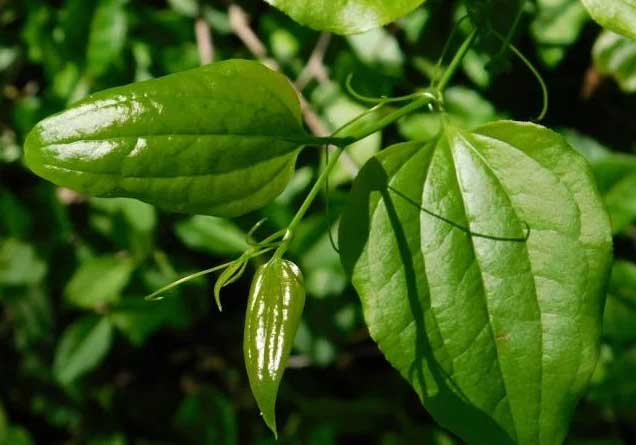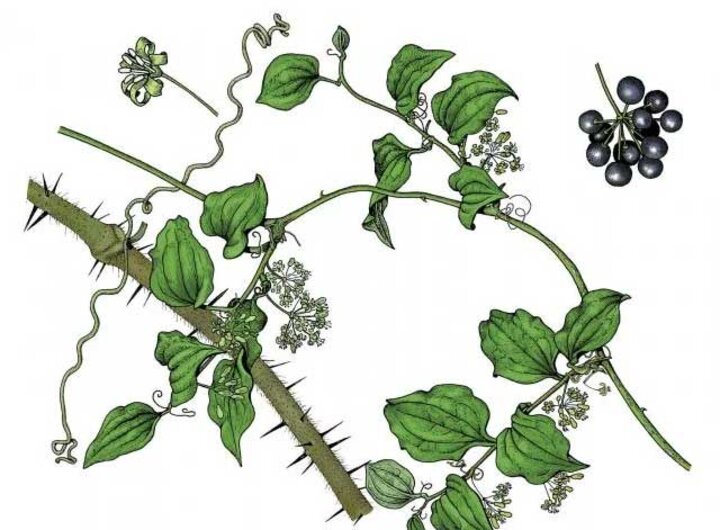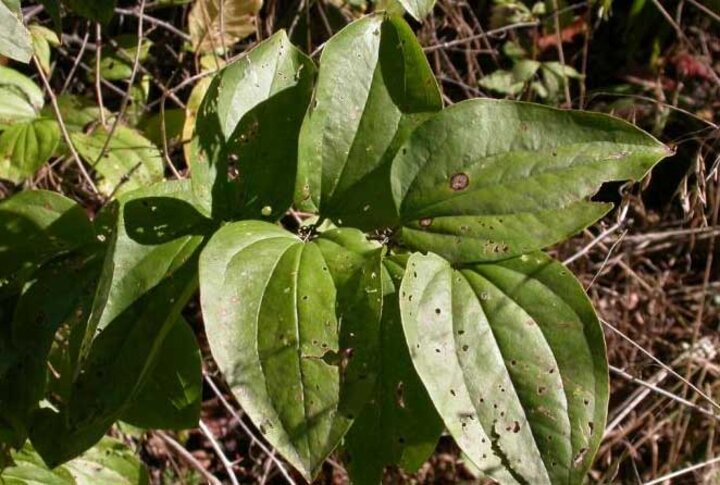Sarah Browning, Nebraska Extension Educator

New shoots of greenbrier growth, with tendrils used for climbing. Images from the Missouri Department of Conservation.
Whenever woody weeds appear in a landscape, they can be especially challenging to control. Common woody weeds include tree seedlings, buckthorn, multiflora rose, ornamental pear, tartarian honeysuckle, poison ivy vines and greenbrier. Often woody weeds originate from seeds eaten by wildlife and deposited at random. But take heart, fall is a good time to control woody weeds, as it is with all perennial weeds.
Greenbrier is not a common problem in most urban home landscapes, but can be found in low maintenance urban areas like bike paths or tree lines. It’s more common in wild areas on acreages and farms. Greenbrier does well in light shade to partial sun in woodlands, thickets, openings in woodlands, or on edges of wooded areas.
Greenbrier is a headache due to its thorns, lots of thorns! Young plants or stems may have small green thorns or none at all. As the stem ages, the thorns enlarge and harden making them perfect for drawing blood.

Family of Thorns
Several closely related thorny plants are found in the Smilax genus and it can be difficult to tell them apart. Although bristly greenbrier is most common in Nebraska, it is possible round-leaved catbrier and common greenbrier could be found as well.
- Bristly greenbrier, S. hispida, has smooth dark green leaves which may be egg-shaped, heart-shaped or oval, 2-6 inches long and arranged alternately on the vines. In early fall, clusters of greenish berries turn blue-black; plant produce stems up to 40 feet long. Foliage is evergreen, persisting on the vines into winter. Leaf stalks are often twisted and bent. The perennial woody stems are green with small white dots and climb via small tendrils like grape vines. By late summer the thorns are nearly black. It’s winter hardy to Zone 4.
- Round-leaved catbrier, S. rotundifolia, a climbing perennial woody vine up to 20 feet long. Range is from Nova Scotia to Florida, west to Texas and north to Illinois. Hardy to Zone 4.
- Greenbrier, S. glauca, has smaller, more narrow dark green leaves. Range is from New England to Florida, west to Texas and north to Illinois. Zone 4.
Plants bloom in May-June, with small greenish-yellow flowers, followed by clusters of green berries. The ripe bluish-black berries provide food for many types of birds and wildlife. Apparently, deer like to browse greenbrier leaves, while turkeys, pheasants, rabbits, raccoons, opossums, birds and other wildlife eat the berries.
Plants form dense thickets, providing cover for birds, rabbits, and others. Greenbrier may be the briar patch in the Brer Rabbit tale, Brer Rabbit and the Tar Baby. If you ever run into greenbrier thorns, you will understand the story!

Greenbrier Control
If plants are small, use an over-the-top herbicide application in fall, mid-September into October. When targeting difficult weeds, don't expect 100% control with one herbicide application. Plan for two applications this fall, 2-3 weeks apart. Plants must have green foliage to take in the herbicide for effective control. Several years of control may be needed to eliminate a dense thicket.
Triclopyr is one of the best products for woody weed control. It is a selective broadleaf herbicide that won't damage grass, but only use it as a careful spot spray around shrubs and ornamental plants since accidental spraying or spray drift will damage or kill them. Triclopyr can be found in products labeled as brush, poison ivy or clover killer herbicides. Use a sprayer to wet the foliage with herbicide, but avoid soaking the soil or allowing herbicide to drift or splash onto non-target plants.
Consider adding a spreader-sticker to the tank mix for even better control. Spreader-stickers are additives that help the chemical applied spread over the weed leaf surface and adhere to it better. When trying to control weeds with waxy leaf surfaces, like greenbrier, a spreader-sticker is particularly helpful. Look for products like Earl May's Turbo Spreader Sticker.
If only scattered greenbrier plants are present, make spot treatments instead of a broadcast application. Or cut down each plant’s stems and paint the freshly cut stumps with concentrated glyphosate.
These control techniques also work for other woody weeds, including those mentioned above.
Final Note
Young greenbrier stems are edible - before they develop thorns, of course! Harvest them in spring and prepare them as you would asparagus. The young leaves are also edible, similar to spinach.
Images from the Missouri Department of Conservation.
- Long thorny greenbrier stems produce dense thickets of foliage.
- New shoots of greenbrier growth, with tendrils used for climbing.
- Greenbrier foliage persists on stems in winter.